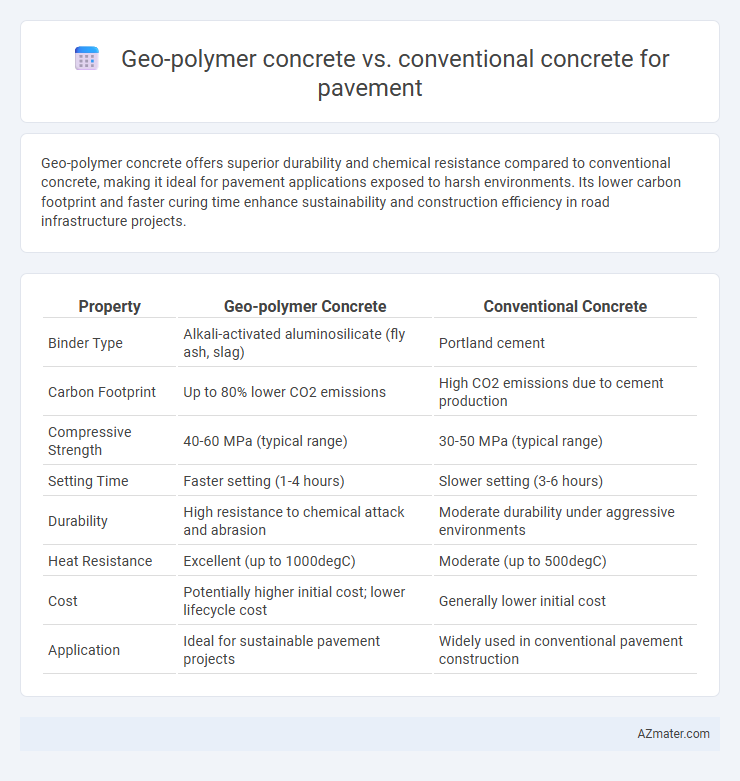Geo-polymer concrete offers superior durability and chemical resistance compared to conventional concrete, making it ideal for pavement applications exposed to harsh environments. Its lower carbon footprint and faster curing time enhance sustainability and construction efficiency in road infrastructure projects.
Table of Comparison
| Property | Geo-polymer Concrete | Conventional Concrete |
|---|---|---|
| Binder Type | Alkali-activated aluminosilicate (fly ash, slag) | Portland cement |
| Carbon Footprint | Up to 80% lower CO2 emissions | High CO2 emissions due to cement production |
| Compressive Strength | 40-60 MPa (typical range) | 30-50 MPa (typical range) |
| Setting Time | Faster setting (1-4 hours) | Slower setting (3-6 hours) |
| Durability | High resistance to chemical attack and abrasion | Moderate durability under aggressive environments |
| Heat Resistance | Excellent (up to 1000degC) | Moderate (up to 500degC) |
| Cost | Potentially higher initial cost; lower lifecycle cost | Generally lower initial cost |
| Application | Ideal for sustainable pavement projects | Widely used in conventional pavement construction |
Introduction to Geo-polymer and Conventional Concrete
Geo-polymer concrete is an innovative material composed of industrial by-products like fly ash and slag, activated with alkaline solutions to form a durable binder, offering enhanced resistance to chemical attack and lower carbon emissions compared to traditional cement. Conventional concrete relies on Portland cement as the primary binder, derived from calcium silicates and produced through energy-intensive processes, contributing significantly to global CO2 emissions. Both materials are used in pavement construction, but geo-polymer concrete provides a sustainable alternative with improved durability and environmental benefits over conventional concrete.
Composition and Material Differences
Geopolymer concrete for pavement primarily utilizes industrial by-products like fly ash or slag as aluminosilicate sources, activated by alkaline solutions, resulting in a binder system free from ordinary Portland cement (OPC). Conventional concrete relies on OPC as the main binder, combined with aggregates and water, creating calcium silicate hydrate (C-S-H) gel upon hydration. The distinct chemical compositions cause geopolymer concrete to exhibit enhanced chemical resistance and lower carbon footprint compared to traditional OPC-based pavement concrete.
Environmental Impact Comparison
Geo-polymer concrete significantly reduces carbon emissions by utilizing industrial by-products such as fly ash and slag instead of Portland cement, which is responsible for approximately 8% of global CO2 emissions. Its production consumes less energy and produces fewer greenhouse gases compared to conventional concrete, making it a more sustainable option for pavement construction. Lifecycle assessments demonstrate that geo-polymer concrete pavements contribute to lower environmental footprints, including reduced resource depletion and minimized landfill waste.
Mechanical Strength and Durability
Geo-polymer concrete exhibits higher compressive strength and superior mechanical performance compared to conventional concrete, making it ideal for pavement applications requiring enhanced load-bearing capacity. Its chemical composition provides excellent resistance to sulfate attack, freeze-thaw cycles, and chemical corrosion, significantly improving durability in harsh environmental conditions. Long-term studies indicate that geo-polymer concrete pavements maintain structural integrity and service life better than traditional Portland cement-based concrete under heavy traffic and aggressive exposure.
Setting Time and Workability
Geo-polymer concrete exhibits a faster setting time than conventional concrete, often reaching initial set within 30 to 60 minutes compared to several hours for traditional Portland cement mixes, which can accelerate construction schedules for pavement applications. Workability of geo-polymer concrete can be tailored by adjusting the activator to binder ratio and the mix design, generally providing comparable or improved flow characteristics, crucial for uniform compaction and surface finishing. Conventional concrete relies heavily on water-cement ratio adjustments for workability, but higher water content can reduce strength, whereas geo-polymer concrete maintains strength with optimized alkali activator content, enhancing durability and performance in pavement structures.
Cost Analysis and Economic Viability
Geopolymer concrete offers significant cost savings in pavement construction due to reduced cement usage, lowering raw material expenses by up to 40% compared to conventional concrete. Its utilization of industrial by-products like fly ash and slag decreases disposal costs and enhances sustainability, contributing to long-term economic viability. Despite higher initial material processing costs, geopolymer concrete's superior durability and reduced maintenance requirements result in lower lifecycle costs, making it a cost-effective alternative for pavement projects.
Performance in Pavement Applications
Geo-polymer concrete exhibits superior durability and chemical resistance compared to conventional concrete, making it highly suitable for pavement applications exposed to harsh environmental conditions. Its rapid strength gain and lower shrinkage reduce cracking and deformation, enhancing pavement lifespan and reducing maintenance costs. Studies show geo-polymer pavements achieve better resistance to abrasion and freeze-thaw cycles, outperforming traditional Portland cement-based pavements in long-term performance.
Sustainability and Carbon Footprint
Geopolymer concrete significantly reduces carbon footprint compared to conventional concrete by utilizing industrial by-products like fly ash and slag, which lowers cement consumption and greenhouse gas emissions. Its enhanced durability and resistance to chemical attack extend pavement lifespan, decreasing maintenance frequency and resource use. Sustainable practices in geopolymer concrete production contribute to reduced environmental impact, supporting long-term infrastructure resilience and climate change mitigation.
Maintenance and Longevity
Geo-polymer concrete offers superior resistance to chemical attacks, abrasion, and thermal cracking compared to conventional concrete, significantly reducing pavement maintenance frequency. Its enhanced durability stems from the use of industrial by-products like fly ash or slag, promoting a denser microstructure that slows degradation. As a result, geo-polymer concrete pavements demonstrate extended service life, lowering lifecycle costs and environmental impact relative to traditional Portland cement-based pavements.
Future Prospects and Industry Adoption
Geo-polymer concrete offers enhanced durability and reduced carbon footprint compared to conventional concrete, making it a promising material for future pavement applications. The industry is increasingly adopting geo-polymer technology due to regulatory pressures for sustainable construction and advancements in raw material availability. Widespread implementation in infrastructure projects is expected as standards and performance data continue to validate its long-term benefits over traditional concrete.

Infographic: Geo-polymer concrete vs Conventional concrete for Pavement
 azmater.com
azmater.com